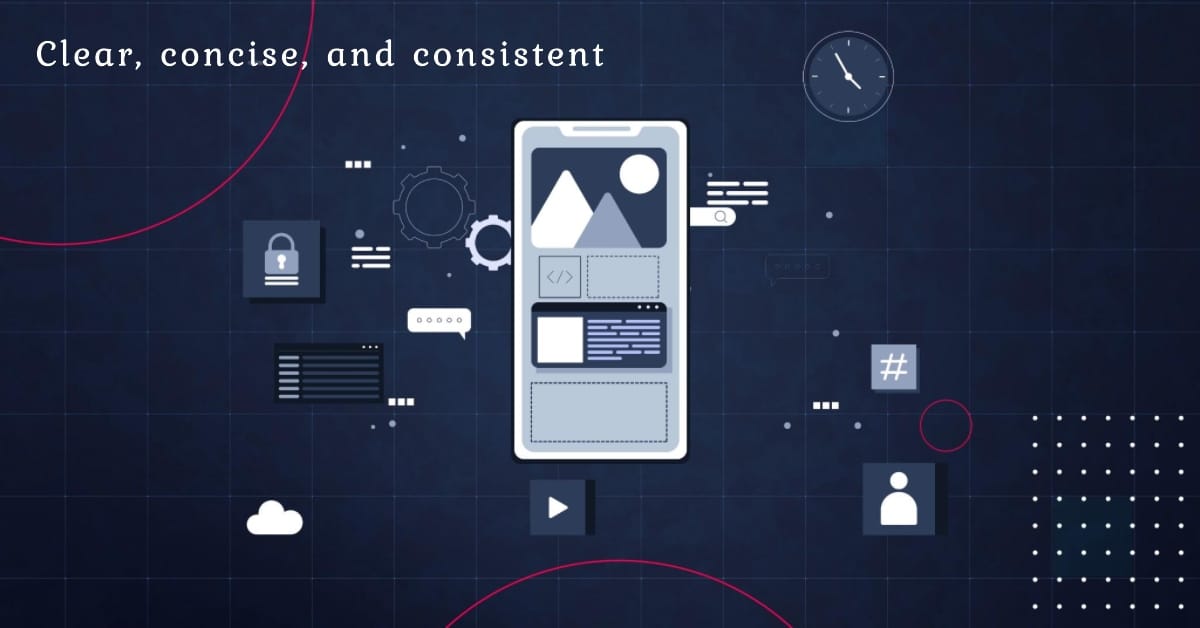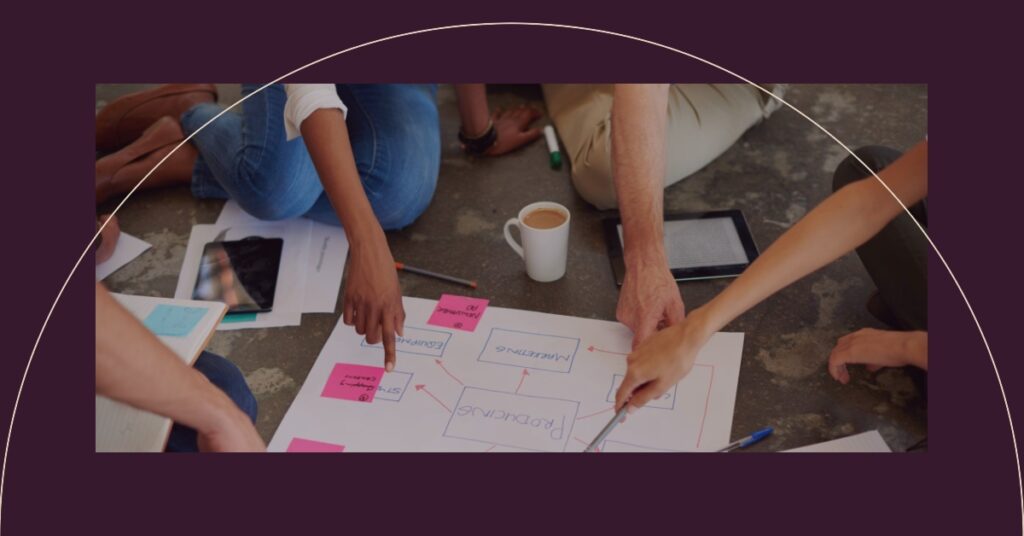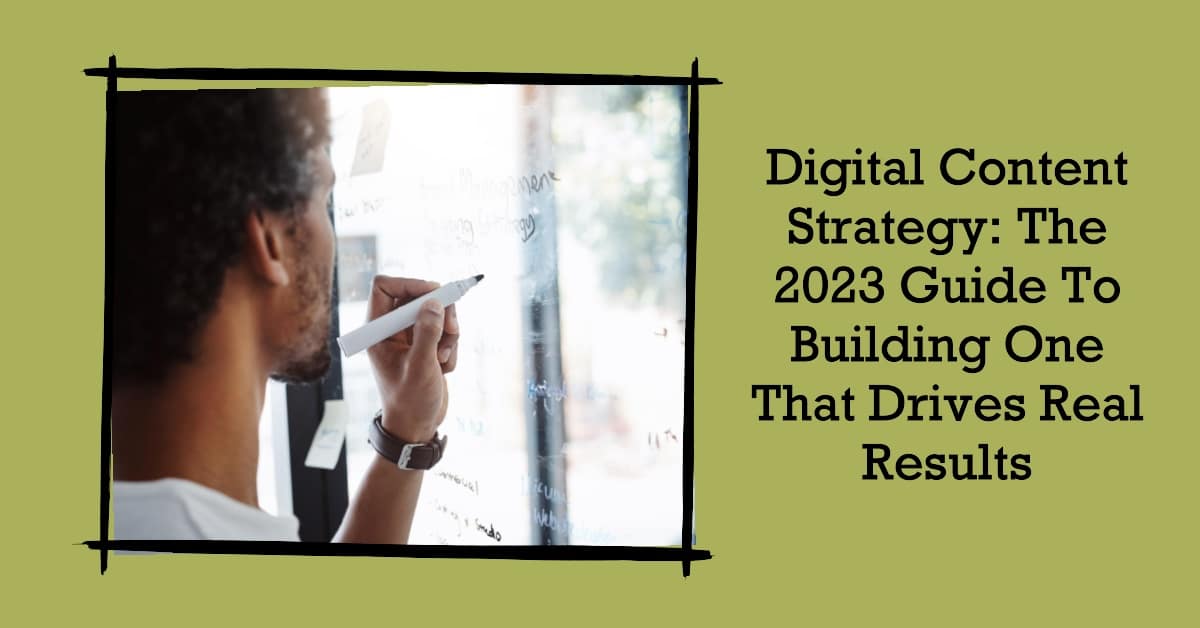A digital content strategy is essential for businesses looking to drive meaningful results online in 2023. With increasing competition for consumer attention across platforms, creating a strategic plan for your content development and distribution ensures relevance, maximize reach and engagement.
This comprehensive guide will take you through the key steps involved in building an effective digital content strategy from the ground up. Follow along to gain actionable insights on auditing your current content, understanding your audience, setting goals, creating compelling content across formats, optimizing for search, distribution tactics and analyzing performance. With the right strategy in place, you can elevate your content game and achieve tangible business wins.
– What is a Digital Content Strategy?
It refers to a research-backed strategic plan to create, distribute, promote and measure relevant online content across channels. It aims to engage target audiences and meet specific business goals through aligned messaging that delivers value.
– The key objectives of having a defined digital content strategy include:
- Attracting and retaining clearly defined audience groups
- Driving conversions and ROI through tailored content
- Establishing thought leadership and brand authority
- Growing organic and incremental traffic
- Gaining a competitive edge
– The core elements of a digital content strategy encompass:
| Element | Description |
|---|---|
| Audience Research | Get a firm grasp of your target personas through demographic, psychographic and behavioral analysis to map their buyer’s journey. |
| Goal Setting | Define specific, measurable goals related to business objectives along with relevant key performance indicators for tracking. |
| Content Creation | Develop exceptional content across formats like longform posts, videos, infographics etc. tailored to address audience needs and questions at different stages. |
| Content Mapping | Map content types and topics to different stages of the purchaser journey for each target persona to guide and nurture them towards conversions. |
| SEO | On-page and technical optimization to boost organic findability and rankings of content. Conduct keyword research for topical optimization. |
| Distribution Strategy | Methodical distribution approach regarding owned, earned and paid channels to widen reach and amplify content promotion. |
| Promotion Plan | Monetize existing distribution by promoting content across email, social media, sales interactions etc. to drive consumption. |
| Performance Analysis | Track metrics like clicks, engagement rate, leads generated etc. to optimize content and strategy further for continuous improvement. |
With a structured digital content strategy fueled by audience insights and data-backed processes, brands can gain sustainable competitive advantage.
What are the 3 C’s of Content Strategy?

The fundamental principles that underpin an effective digital-first content strategy can be encapsulated in the essential 3 C’s:
1. Clarity:
The bedrock of any impactful digital strategy lies in absolute clarity. It demands a meticulous alignment of content purpose and messaging with the specific needs of the audience at every stage of their journey. It involves the art of streamlining ideas, ensuring that they are presented in a manner that is readily comprehensible and resonates with the target audience.
2. Conciseness:
Recognizing the limited attention spans of the modern digital consumer, content must be crafted with skimmability, scannability, and directness in mind. This necessitates condensing ideas without compromising their impact. In a world where time is a precious commodity, the ability to convey information succinctly is crucial to capturing and maintaining audience attention.
3. Consistency:
The trust-building pillar of a it is unwavering consistency. This involves maintaining a dependable schedule for the publication of high-quality, valuable content across diverse channels and formats. Predictable excellence not only establishes a brand’s reliability but also fosters a sense of trust and loyalty among the audience.
Ingraining these 3 C’s into the fabric of your digital first content strategy is the linchpin to effectively engage and convert audiences. These criteria should function as guiding principles for your content strategy team, influencing decisions pertaining to content architecture, the creation of assets across various formats, and the ongoing analysis of performance for continuous optimization. A strategy grounded in content that is consistent, concise, and clear is poised to accelerate success in the dynamic landscape of digital content strategy.
The 2023 Guide to Building a Winning Digital Content Strategy That Drives Real Results is

Defining Digital Content Strategy
At its core, a digital content strategy outlines a strategic approach to creating, curating and distributing digital content across channels in order to meet specific business goals. It encompasses the entire content lifecycle – from ideation to measurement and refinement.
The key elements of a content strategy include:
- Research-backed insights into your buyers and audiences
- Clearly defined goals and success metrics tied to business objectives
- Mapping of engaging content to buyer’s journey touchpoints
- Content gap analysis indicating opportunities
- Guidelines for content development processes
- Distribution and promotion strategy across formats and platforms
- Analytics and optimization plan
The overarching goals of an effective digital content strategy are to:
- Attract and engage your target audiences by meeting their needs/interests
- Drive conversions and ROI through tailored content that compels action
- Establish brand authority and trust through high-quality content
- Increase organic visibility and website traffic
- Gain competitive advantage by prioritizing underserved topics
With content integral to brands’ digital footprint and go-to-market approach today, getting your content strategy right can have a tremendous impact. It leads to higher brand awareness, increased lead generation and sales and more. Annual updates ensure it stays relevant.
Conducting Research on Your Audience
Gaining crystal clear insights into your existing and potential audiences/buyer personas is step one when developing your digital content strategy. By unraveling who your customers are, their pain points and defining characteristics; you gain the customer intelligence required to create content that resonates.
There are several dimensions on which to research your audiences:
Demographic details: This covers factual data like age, gender, location, income level and more. Useful for understanding population segments.
Psychographics: Goes a layer deeper into aspects like lifestyle, values, beliefs, motivations and interests. Critical for relating to audiences as people.
Behavioral habits: Essential for mapping your audience’s journey. Research their online search behavior, browsing habits, content and site preferences, shopping patterns and so on.
Market segmentation: Split your broader target market into distinct groups that have common needs and attributes. Create differentiated content strategies for each.
Seasonality or external events: Certain industries see changes in audiences and interests based on seasons, holidays or real-world happenings. Stay on pulse.
Powerful audience research tools include surveys, interviews, social listening, web analytics, Keyword Planner and more. Derive actionable user personas and segments to guide content development.
Setting Measurable Goals and KPIs

The next building block of an impactful digital content strategy is identifying goals that align to overarching business objectives and KPIs to track. This forms the crux for measuring content success.
Types of achievable content goals:
- Increase website sessions by 20% in 6 months
- Generate 150 new MQLs per month
- Achieve 30% increase in average time-on-site
- Improve domain authority from 67 to 75 in a year
- Get 60% of traffic from organic searches
- Grow social media followers by 15%
KPIs based on goals set:
- Website traffic
- Bounce rates
- Pages per session
- Conversion rates
- Lead volume/MQLs
- Sales revenue
- Search rankings
- Social media followers
Choose 2-4 relevant goals per persona/content area along with correlated KPIs for easy tracking. Of this, make sure 1 relates to business revenue to showcase content impact on the bottom line.
Creating Different Types of Content
With your audience insights and content goals cemented, it’s time for the ideation and creation stage. Compelling content is about variety – different formats, lengths and styles tailored to buyers’ needs across the journey.
Build a thorough content calendar for the year considering seasons, new offerings and campaigns. Then map relevant formats to each persona’s pain points at every stage.
Types of engaging content to leverage:
Long-form written content
- In-depth guides and ebooks
- Detailed reports/whitepapers
- Researched trend pieces
- List posts/roundups
- Ultimate guides
Value: Enable showcasing expertise. Full exploration of topics for heavy research-based buying stages. Attract backlinks and shares.
Short-form written content
- Blog articles
- News section
- Testimonials
- Interviews / Podcasts
- Infographics / stats posts
Value: Easy to skim and consume. Adapt for different attention spans. Current and conversational.
Visual content formats
- Original images and graphics
- Animated gifs
- YouTube videos
- Interactive content formats
Value: Variety in storytelling formats. Increased engagement. Branding elements.
FAQ sections
Value: Directly address audience questions. Opportunity to guide customers and reduce objections.
Craft buyer personas and map ideal content types to various stages of their journey with your brand. Then interlink complementary content across funnels using CTAs.
Optimizing Content for Search and Prominence
With content creation in full swing, optimizing it for search visibility and prominence is key. This allows you to expand organic reach and traffic to your content and site overall.
On-page SEO best practices:
- Include primary keyword in headline tags and once in first 100 words
- Structure content under headings using keywords
- Create useful internal links to related content
- Include relevant meta description
- Use alt text and file names with keywords
- Optimize page speed and technical SEO
Streamlined keyword research process:
- Identify commonly searched questions around topics
- Leverage tools like Keyword Planner for volume and competition data
- Derive long-tail variations around core terms
- Expand into semantic keyword groups
Formatting content for voice search applicability
- Frontload content with concise paragraphs
- Use natural language and conversational tone
- Make content scannable with bullets
- Include FAQs and answers in content
Driving organic search visibility compliments your distribution efforts. Give your content the best chance to get found by searchers and recommended by Google through these steps.
Distributing and Promoting Content
Creating amazing content isn’t enough if audiences you want to reach never discover it. Promoting and distributing content through the right channels is integral to ensuring target personas consume and engage with it.
Leverage a combination of owned, earned and paid tactics:
Owned assets
- Feature on homepage displays
- Email newsletter inserts
- Social media channels – organic and paid
- Sales collateral inclusion
Earned amplification
- Pitch guest posting opportunities
- Promotions by brand advocates
- Secure influencer mentions
Smart paid boosts
- Facebook/Instagram/Pinterest promotions
- Quora/Reddit ads
- Buy email newsletter sponsorships
- Book paid social media ads
Map relevant formats to stages across the conversion funnel and showcase content in places your audiences already spend their time. Don’t keep your hard work hidden. Implement buzz marketing tactics for increased visibility.
Analyzing Performance and Results

The work doesn’t end once your content goes live. In fact analyzing how each piece performs is vital to identify what resonates with your audiences and what doesn’t.
Key metrics to actively track include:
- Pageviews and unique visits
- Scroll rates
- Time-on-page
- Social amplification rate
- Links earned
- Search visibility improvement
- Conversion rates from specific pieces
Tools to leverage for analysis and insights:
Analyze content performance from creation to results consistently. Figure out which topics and formats your audiences naturally gravitate towards. Similarly, identify underachievers in terms of engagement and conversions. Then use these insights to plan better quality and higher performing content going forward.
Maintaining Consistency and Momentum
With the core of your digital content marketing strategy set up, the key is maintaining consistency. Set processes to keep content development and publishing regular across your owned platforms.
How to build consistency into your approach:
- Maintain detailed content calendars per persona
- Set and assign quarterly content creation goals
- Establish structured approval work flows
- Automate and schedule social media posts
- Create trackable analytics dashboards
Also focus on flexibility – stay on pulse with current affairs and trends to identify real-time hooks and opportunities to connect with audiences through contextual content.
Empower all team members involved in content creation and distribution with clear guidelines, best practices and access to performance data. Identify skill or knowledge gaps for future training.
Keep evolving the content strategy based on latest insights into personas, business goals and content types that deliver ROI. Audit and revamp the approach every 6 to 12 months.
What are the 3 components of content strategy?
The three key components of content strategy are:
1. Planning and Development: This involves the initial stages of content creation, including research, goal setting, audience analysis, and the strategic planning of what content to produce. It encompasses the ideation, creation, and structuring of content.
2. Implementation and Distribution: Once the content is created, the next step is to implement the strategy, which includes distributing the content across various channels and platforms. This phase involves utilizing owned, earned, and paid media to reach the target audience effectively.
3. Analysis and Optimization: The final component revolves around evaluating the performance of the content. This includes measuring key performance indicators (KPIs), analyzing user engagement, and using the insights gained to optimize future content. Continuous analysis ensures that the content strategy remains aligned with business goals and audience preferences over time.
Implementing a structured digital content strategy fuels tangible results only when it puts audiences needs and interests first while meeting business objectives. Getting a sound understanding of your buyers and where they look for information is the genesis of stellar content experiences across the purchase journey.
This comprehensive guide covered all aspects of creating a robust digital content approach – from upfront research, setting measurable goals and KPIs, mapping engaging content formats to each buyer stage, repurposing across formats, calculated distribution to amplify reach and consistent tracking of performance data.
Importantly, align your content production with the pillars of your overarching strategy. Build teams with niche expertise across different formats – text, visual, video and more. Provide them insights into audience interests to craft tailored content assets. Equip them with best practices for on-page SEO and promotion support needed once published.
Keep your audiences and competitive landscape at the epicenter to build a living content marketing machine. One that attracts, converts and delights at scale as their needs evolve. Recurring evaluation ensures your digital content strategy delivers increasing value.
Now you’re armed with actionable recommendations to either kickstart or revamp your content production and distribution approach. Feel empowered to strengthen resonance with audiences to tangibly grow your business outcomes.
FAQ
Ideally review and refresh your digital content strategy every 6 to 12 months. Annual works for most use cases in order to account for changing company offerings, seasonal shifts in engagement trends and evolving audience preferences.
Focus on visual content that aligns to your expertise and audiences. Repurpose top written and video content into snippets and graphics using free tools like Canva. For affordable stock images, check out Unsplash or Pexels. User-generate visual content whenever you can.
Strive for an intentional balance of long-form and short-form content pegged to audience needs in specific contexts. For instance, in-depth guides work well at the early research stages while quick tip posts suit further down the funnel. Mix and match.
Gating select premium long-form content behind opt-ins in exchange for lead generation data works well. Ensure you still have open-access educational posts mixed in across the buyer’s journey.
There are no fixed rules, ensure you stay fresh and visible without overwhelming readers. Tailor frequency based on resources, audience demand and conversion potential from blog content on site.
Take regular performance checks. For underperforming content, assess if it suits the audience life cycle stage as intended. If yes, amplify it more on relevant platforms. If not, assess content gaps to rewrite it or create alternatives that add value.
 Anas is our go-to copywriter with a knack for crafting persuasive and high-converting eCommerce landing pages. His passion for words and understanding of consumer psychology helps turn visitors into loyal customers. When he's not refining his copy, Anas enjoys exploring the latest digital marketing trends and experimenting with new writing techniques. His blend of creativity and strategic thinking makes him an indispensable part of our energetic team.
Anas is our go-to copywriter with a knack for crafting persuasive and high-converting eCommerce landing pages. His passion for words and understanding of consumer psychology helps turn visitors into loyal customers. When he's not refining his copy, Anas enjoys exploring the latest digital marketing trends and experimenting with new writing techniques. His blend of creativity and strategic thinking makes him an indispensable part of our energetic team.












